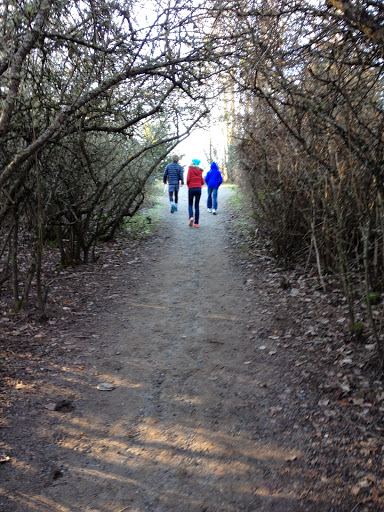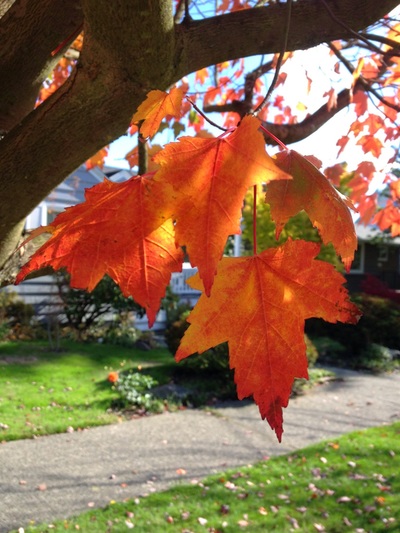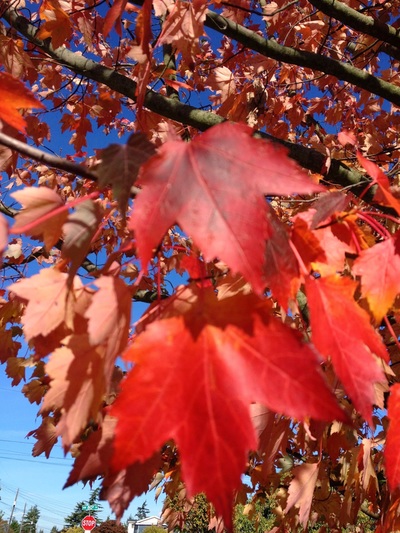|
Immersion in the natural world is a central aspect of healthy child’s play. Play, that involves our hands, is richly connected with our brains, and a primary way we interact with our world. As kids play with blocks, fashion mud pies, and throw balls, they are constantly fertilizing neural growth and integrating complex areas that the natural world offers. ~from an article by Stuart Brown, MD Founder of the National Institute for Play The benefits are amazing and the effects are lasting. There is evidence that a connection to nature enhances social skills, mental cognition and emotional health. Your child will learn empathy for living things, develop self-regulation and have a reduction in stress (sadly childhood depression and stress are on the rise) when being in nature. It is important for your child to spend non-structured time in nature. The time you spend outside will have a long lasting impact on your whole family.
It is important to help the kids engage in nature and then step back and let them use their imaginations. It is great to see where they go! You are the first step in connecting your child to nature. If they do not know nature they cannot love nature. You cannot love something you do not know. There are many benefits of being outside.
http://rainorshinemamma.com/ North Carolina State University – Natural Learning Initiative: Benefits of Connecting Children with Nature Being in nature is a gift you can give your child that will stay with them for their whole life!
April is a time for dreams for a gardener….what is new in the garden today? what shall I plant? when can I go outside and dig in the dirt?! My boys loved to be outside digging in the dirt. As soon as the weather warmed up enough to plant we went outside to “put in our garden”. Of course, it was nothing like Great Grandpa’s garden at the farm in Ohio but it was ours. We always had corn (which was never knee high by the Fourth of July and we seldom got to eat it because the raccoons got there first!), carrots, zucchini, tomatoes, blueberries, pumpkins (that never got very big), strawberries, raspberries, cherries and, when they got older, peppers and cilantro for salsa. 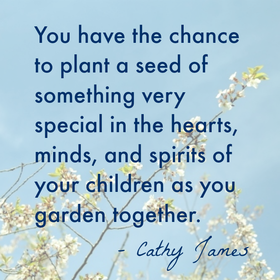 Ours was an “eating garden” not the “canning gardens” they ran through when visiting the relatives in Ohio. It was there for them to experience the joy of growing something, to see where some of our food comes from and to be able to taste the goodness of their harvest (if we could keep the raccoons and birds from experiencing it first!) We would take pictures of their two corn stalks and send them to Great Grandpa – I am not sure who was prouder of their corn. When they got to high school they both took horticulture. The teacher came up to me one day and asked if Joel and Nick had gardened when they were younger. I said they had and she replied, “I knew it. They have such a respect for living things.” It is so important to let little ones nurture things from nature. They develop an empathy and a respect for living things when they garden as well as a knowledge of where food comes from, experiencing the science of growing seeds, patience while waiting for their plants to produce something to eat or look at, and pride in what they have accomplished. This love for nature will stay with them. Joel and Danielle have been working on the garden at their home Wedgwood. Nick does not have garden space but he likes to read books on gardening and loves planning a menu to eat all the things that Joel is growing! My Grandfather would be so proud of his little gardener. I am glad we had, and are still having, fun digging in the dirt together. Children love to see the plants and see where food comes from before it gets to the grocery store. Take them to a blueberry or strawberry farm and let them pick some fruit. Then let them help prepare the food for a family meal. You know where food comes from but to them this is a new and exciting adventure. Take some time to get dirty with your child – or just visit the pea patch and see what other people are doing in the dirt. 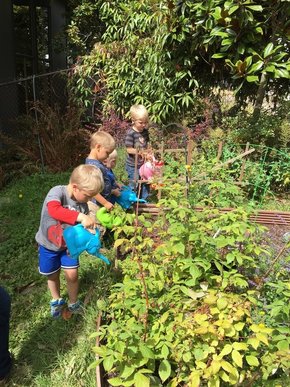 Kids watering the plants in our garden at preschool. Kids watering the plants in our garden at preschool. Some of the children have already had the opportunity to plant seeds in the garden at preschool. We will all be planting soon. We will encourage the science of gardening while we set up experiments outside and have fun digging in the dirt at preschool. Be sure to check out the garden area when you are at school --The raspberry plants are leafing out, the hummingbird is visiting on a daily basis and the slugs are enjoying our primroses. There is a lot going on in the preschool garden. And more to come! Our Wildlife Habitat Garden has attracted the birds this winter and soon the butterflies will return. The garden is a place that allows the children to experience nature and encourages habitats for the animals in the area. When we encourage children to be a part of nature they develop a caring attitude toward nature that develops their ability to nurture – plants, animals and people. Happy Spring!
Fall is a time of change – the leaves change to a variety of colors, we anticipate the change in the weather and temperature, sunsets come early and sunrise later, we watch the last of the flowers in the garden fade away. We change our clocks, our meal choices and our wardrobe...time for all those sweaters and fleece to come back out of the closet where they have been (although in Seattle it may have only been for a few weeks!) While we look forward to change we may long for time to stay the same. I enjoy the crisp, colorful days of fall, but long for the lazy, sunny days of summer while looking forward to cold, snowy days by a fire in the winter. I want it to stay the same yet remember the fun of the past and look forward to the new of the future. This is true of parenting. I loved when my sons were young. I was always happy with the age they were. We enjoyed all the “seasons” as they grew. All were wonderful and different and challenging. The joy of the “firsts” -- first smile, first words, first steps changed to first lost tooth, first sleep over, first summer camp. Then it was time for learning to drive, college applications and their first time living away from home. We have enjoyed the time with our sons and being a part of the changes as they have grown from babies to adults. We cannot turn back the hands of time. What we can do is to look back at the memories as we look forward to the new experiences to come. This month I would like to write about my passion for the outdoors. It is so important to be outside with your children. I have to be outside. I have always been an outside kind of person. I draw so much energy from nature and being able to be outdoors. When our sons were little we did as much as we could outside. Hiking, exploring, walks in the neighborhood, visiting parks, camping and looking for worms after a rain were just some of the activities we enjoyed. This fall we will have opportunities to spend time outside in our play area to give the children different ways to exercise their bodies while being in a natural environment. They need to experience the wonder of the trees movement when it is windy, the smell of the salt air, the feel of mist on their skin. While we are at preschool these are all things they can experience in the little window of nature while we are at Outdoor Play. What do they learn while they are outside? All of their 5 senses are used while in nature. They can hear the birds, feel the wind, watch the clouds, taste a fresh picked vegetable or fruit and smell a flower. They can watch a spider spin a web, a bird soar in the air and a squirrel run up a tree. While they dig in the dirt (or sandbox) they are learning about physics and math, when they pet an animal they are learning how to interact in a kind and gentle manner, when they watch the world around them they are discovering that this is a big world and they are a part of it. It is so important for children to be given opportunities to explore their world. Independently! Give them time to roam about, by themselves, and explore. No, I am not saying just let them run about in an unsafe environment where they could be injured but do give them opportunities to explore their world and to be independent. Give them an opportunity to explore the backyard while you watch from a distance. Let them interact with nature by climbing, sitting, running and exploring their yard (or safe outdoor area) on their own. It is just as important to be there to explain the world around them as it is for them to have a chance to experience the world of nature on their own – to develop critical thinking skills (what to believe, what to do), curiosity (what is this ...), imagination (what can I do with this) , problem solving skills (how do I climb up this rock) , and a joy of learning (developing a love of learning for learning not for a grade or the approval of others). One way to do this is to give them an area to dig. This could be in a sandbox, at the beach, in a pile of dirt or a space in the garden. Let them use natural materials, like sticks and rocks, to build with. Our sons had a huge (Curt does not do anything little) sandbox to play in. They would spend hours building roads for their vehicles, homes for their animals and dinosaurs, digging for buried treasures. I would sit nearby and read or we would build together depending on how they wanted to play that day. It was a delightful way to spend a sunny afternoon. When we treat children's play as seriously as it deserves, we are helping them feel the joy that's to be found in the creative spirit. It's the things we play with and the people who help us play that make a great difference in our lives. As our sons grew their “sandbox world” changed to scaling the boulder in the Cougar Rock Campground at Mt Rainier National Park, exploring my Grandfather’s farm in Ohio, Ultimate Frisbee games at Discovery Park and hikes in the North Cascades with their friends. Nick has climbed 4 of the highest mountain peaks in Washington. He has summited Mt Rainier, Mt Baker, Glacier Peak and Mt Olympus. The year he was summited Mt Olympus Joel and Danielle climbed Half Dome in Yosemite. Greta loves the outdoors as much as Nick. We are in the process of planning some adventures next summer with all of them. I would like to think that part of Joel and Nick’s love to explore the outdoors, and the world around, was inspired by the worlds they created in their backyard sandbox. A FUN FALL NATURE ACTIVITYTake a COLOR WALK – Learn about the colorful diversity of nature and the usefulness of camouflage. Gather squares of different colored paper – or let your child pick out some paint-chip cards at the store – and go on walk around the neighborhood, your backyard, or the park. Collect things that match your color cards. Green – grass, Yellow-dandelions, Red- leaves, Brown-pinecone, etc. ( you can point out that at this time of the year all the colors that the leaves are) You can collect them in a plastic baggie or gather them up and place them on the sheets of colored paper. Talk about the colors and size of the items you collect. Talk about what colors are easy to find, what color is your favorite, where do find colors, how many colors are in the sky. See if you can name something from each color. Take some time to allow your children to explore the world around them and plant a seed of curiosity that will grow with them.
Research suggests that children might build stronger immune systems, play more creatively, and have more active imaginations when they play outside. Fjortoft 2004; Burdette & Whitaker 2005 What do children learn when they play outside?
All of these activities strengthen a child’s physical literacy. Physical Literacy is the fundamental movement skills and fundamental sport skills that permit a child to read their environment and make appropriate decisions, allowing them to move confidently and with control in a wide range of physical activity mastering of situations. When children are outdoors they become more aware of how their body works. They can run, jump, swing or sit, scoop, listen. Nature time allows them to interact with the world in many ways – quiet ways as they watch a hummingbird or listen to the water hitting the shoreline. They have the chance to hear loud sounds as they hear the waves crashing onto the rocks as the tide changes or use their own voice to make an echo. They can build their knowledge of physical sounds as they hear the splash from the rock that they toss in the water compared to the sound of a rock hitting the hard surface of the larger rocks. They are building their vocabulary as they gain knowledge of objects found in nature and how that object looks, feels, sounds, tastes, smells. It is not the same as a Google search of the same object. Touching a rock and turning it over in your hand – the feel of the cold rock as it turns warm from your body heat cannot be explained on Google as well as it can be explained by experience. What are some activities that promote body knowledge through play in nature? Some of these activities need nothing other than being outside and some will need a few items from the house but all can be done by toddlers and preschoolers with a little adult assistance.
Nature Tape Bracelets: using a piece of clear packing tape, sticky side up, make a bracelet around your child’s wrist. As you walk around the yard or park, pick up things of nature to add to your bracelet. This is a time to teach your child names of plants and respect for living things as well as personal property. I had quite a conversation with my nephew as to why we could pick buttercups and dandelions, but not from the neighbor’s hydrangea bush. In our play area at preschool we made bracelets from ferns, grasses, buttercups, lilac blossoms, small pine cones and feathers I had purchased. Treasure Hunt: Make a map of places on your walk ahead of taking your child on the walk. The treasure map can be drawings or with pictures from your phone. At the end of the walk you can bury a surprise for them to find. We would walk through Discovery Park and in the sandy area by the bluff they would dig up the buried treasure…a baggie of snacks or a little toy that someone had buried ahead of the children getting there. We would have that person stand nearby to keep puppy dogs from getting the treasure before the kids get there ;-) Surprise Homes: Leave a piece of cardboard, cloth or plastic in an area of dirt or bark. After a few days have the child lift up the cover – it is amazing to see what little creatures have made a home under the cover. Worms, potato bugs and slugs love to live under those covered areas in the dirt. Build a Village: Using twigs, rocks and your imagination build little pretend homes for the “little people”. With children in our neighborhood we built a Leprechaun Village, We used leaves for beds and dandelions flowers for pillows, rocks and bark to build tables and chairs, pine cones were made into walls and sticks were telephone poles. They even created a pond with boats and a dock. We would look for treasures the Little People would leave us (small treats) and we would leave them shiny rocks or marbles. The village stayed under my plants in my garden for the whole summer. Scientific Search: Using child safe magnifying glasses and/or binoculars go on a walk in search of __________. You can go on a rock search, a bird search, a tree search or a flower search. I have plasticized cards with animals, plants, trees on them. A mom came up with the idea of using an erasable marker to cross off what you find on the walk. You can make your own from pictures and put contact paper over the paper for protection from the elements (and makes them tear-proof and re-usable for more walks) Read a Book: Read a book outside under a tree. It is a great way to introduce literature and just enjoy time together in nature. Watch the Clouds: In Seattle we lots of cloudy days but we do not often get the kind of clouds that you can just watch – the big, fluffy, white clouds. On the days we do take a blanket and go outside. While you lay and watch the clouds you can: talk about what you see, talk about colors and texture or just lay and watch without talking at all. Clouds are amazing. Worm Walks: After a rainy day (or on a rainy night) take flashlights and go outside for a walk. You will be surprised at the earthworms that are stretched out on the sidewalks. On some nights we would count 10 on just one sidewalk square. Try to catch one – they are fast and slippery. If there are no worms out - it is still fun to be outside with flashlights! Puddle Stomping Walk: Oh the fun of splashing in puddles. We had a favorite route to take after a rain storm – lots of big puddles for stomping in. Kids love puddles and there are a lot of discoveries you can make. How big of a splash, can you walk without making a splash, watch the ripples after the splash, look at the reflections in the still water and in the water after the splash -- These are fun questions to ask your child. Respectfully listening to their ideas and thoughts is one way to build a strong relationship with your child. No puddles to be found? Or your child (or you) prefer not to get wet -- Storm drains are fascinating with the rain water running into them and the sound that makes. |
CategoriesArchives
June 2021
Links |






